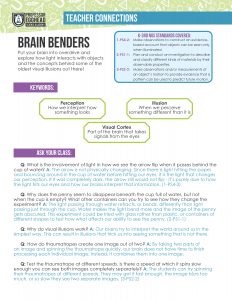This week, we’re going to be putting our brains into overdrive as we explore the concepts behind some of the oldest Visual Illusions out there! While we’re at it, we’ll learn a little bit about how light interacts with different materials, how our brains sometimes play tricks on us, and...how many legs an elephant really has? Hmm. Don’t get your eyes checked just yet - we’ll get to the bottom of this!
Keywords
- Perception
- Illusion
- Refraction
- Visible Light
materials list
- Clear glass or cup filled with water
- Coin
- Piece of paper
- Markers/colored pencils/crayons
- Vegetable oil (~¼ - ½ Cup)
- Pencil
- A few sticky notes (or stiff paper/cardboard that is approximately 3x3 in)
- Tape
background
The word PERCEPTION means how we think something looks. So if I look out the window today, I am perceiving the sky to be blue and the trees to be green. But sometimes, what we perceive is not the truth of what actually exists. Today we will learn about how we can trick our brains into perceiving things that aren’t actually there! When something looks different than it physically is, it’s called an ILLUSION.
One type of illusion we’ll explore is called REFRACTION. When light travels from one medium (like air) into another (like water) it bends, or refracts and what we perceive looks different than how the object actually looks. We’re used to seeing light as it moves through air - a singular medium. In this lesson, you’ll observe how different mediums (water, and oil) make the light bend. As you’ll see, different materials bend light different amounts.
We know that the object isn’t changing shape, so why doesn’t our brain adjust what we see? The part of the brain that makes sense of what we see is called the visual cortex. The visual cortex is a place in the back of the brain that receives and makes sense of all the information coming from the eyes. When we look around us, the brain takes information about light, shadows, shapes, and sizes of things that we see, and creates a picture. The range of light that we can see is VISIBLE LIGHT. We see a lot of things at once, so to process the information quickly, our brain takes general parts of what we see and fills in the rest. When our brain fills in the missing information improperly, it causes us to see a visual ILLUSION. Visual illusions are pictures that play tricks on the brain, making things look different than they actually are. There are different kinds of visual illusions. Some illusions are pictures that are actually two or more images blended together. While one person sees one image, another person sees a different image. There are also illusions that trick us into thinking that parts of a picture are moving, when actually there is no movement at all. We’ll look at a few visual illusions in this lesson, so be sure to read about how they each work.
One that we’ll spend more time on is the color spinner. When spun really quickly, we see white. All the colors get blurred and combine together because the wheel is spinning too fast for our brains. Our brains can’t see all the colors separately, so instead it combines them together. Whenever you see white light, you’re really seeing all colors combined together. You may ask then why do I get mucky brown or black if I mix paints together? There’s a difference in mixing LIGHT rather than INK or PIGMENT. The color that you see from the spinner is light combining together - when you add colors of light together, they get lighter until we just see white. Inks are the opposite, the more of them you add, the darker the color gets until we reach black.
For the last experiment, we will make something called a thaumatrope (come from Greek - thauma=wonder, trope=turn). If you’ve ever used a flip book, you know that when you flip the picture book really fast, it looks like a movie. For the same reason that our brain combined the colors of the wheel in the last demonstration, when you flip through a flip book or spin the thaumatrope, our brain combines the pictures together so it looks like it’s moving.
keywords
PERCEPTION: How we think something looks
REFRACTION: When light bends because it passes through an object
ILLUSION: When something looks different to you than it really is
VISIBLE LIGHT: The colors of light that we can see

